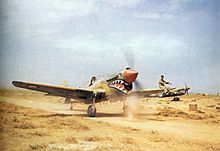 Loading... Please wait...
Loading... Please wait...| Hobby Master 1:72 HA5506 Kittyhawk Mk IV RNZAF No.4 Servicing Unit, Gloria Lyons |
||||
|---|---|---|---|---|
| Scale: 1:72 |
Length: 5.5" |
Width: 6.25" |
Composition: Diecast |
SKU: HM-HA5506 |

Historical:
“Gloria Lyons” adorned four different New Zealand Air Force aircraft. The first three were P-40 Kittyhawks and the fourth was an F4U-1A. Gloria Lyons was a nineteen year old New Zealand girl with tuberculosis and pen pals with members of the No. 4 Servicing Unit in the Solomon Islands. The unit decided to make her their mascot and added her name to the engine cowling. The first two P-40s as well as the F4U-1A were destroyed but the third P-40N, NZ3220 survived the war. The real Gloria Lyons overcame her tuberculosis.
The Curtiss P-40 Warhawk is an American single-engined, single-seat, all-metal fighter and ground-attack aircraft that first flew in 1938. The P-40 design was a modification of the previous Curtiss P-36 Hawk which reduced development time and enabled a rapid entry into production and operational service. The Warhawk was used by most Allied powers during World War II, and remained in frontline service until the end of the war. It was the third most-produced American fighter, after the P-51 and P-47; by November 1944, when production of the P-40 ceased, 13,738 had been built, all at Curtiss-Wright Corporation's main production facilities at Buffalo, New York.
P-40 Warhawk was the name the United States Army Air Corps and after June 1941, USAAF-adopted name for all models, making it the official name in the U.S. for all P-40s. The British Commonwealth and Soviet air forces used the name Tomahawk for models equivalent to the P-40B and P-40C, and the name Kittyhawk for models equivalent to the P-40D and all later variants.
The Tomahawk was superseded in North Africa by the more powerful Kittyhawk ("D"-mark onwards) types from early 1942, though some Tomahawks remained in service until 1943. Kittyhawks included many improvements and were the DAF's air superiority fighter for the critical first few months of 1942, until "tropicalised" Spitfires were available. In 2012, the virtually intact remains of a Kittyhawk were found; it had run out of fuel in the Egyptian Sahara in June 1942.
DAF units received nearly 330 Packard V-1650 Merlin-powered P-40Fs, called Kittyhawk IIs, most of which went to the USAAF, and the majority of the 700 "lightweight" L models, also powered by the Packard Merlin, in which the armament was reduced to four .50 in (12.7 mm) Brownings (Kittyhawk IIA). The DAF also received some 21 of the later P-40K and the majority of the 600 P-40Ms built; these were known as Kittyhawk IIIs. The "lightweight" P-40Ns (Kittyhawk IV) arrived from early 1943 and were used mostly as fighter-bombers. From July 1942 until mid-1943, elements of the (57th FG) were attached to DAF P-40 units. The British government also donated 23 P-40s to the Soviet Union.
Tomahawks and Kittyhawks bore the brunt of Luftwaffe and Regia Aeronautica fighter attacks during the North African campaign. The P-40s were considered superior to the Hurricane, which they replaced as the primary fighter of the Desert Air Force.

Info: Kittyhawk Mk IV RNZAF No.4 Servicing Unit, Gloria Lyons
